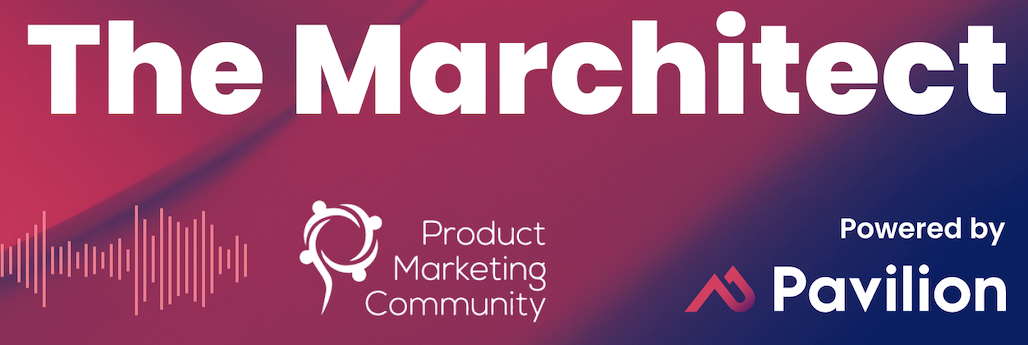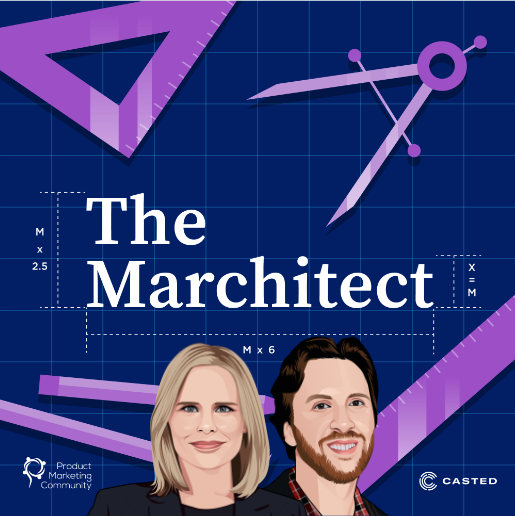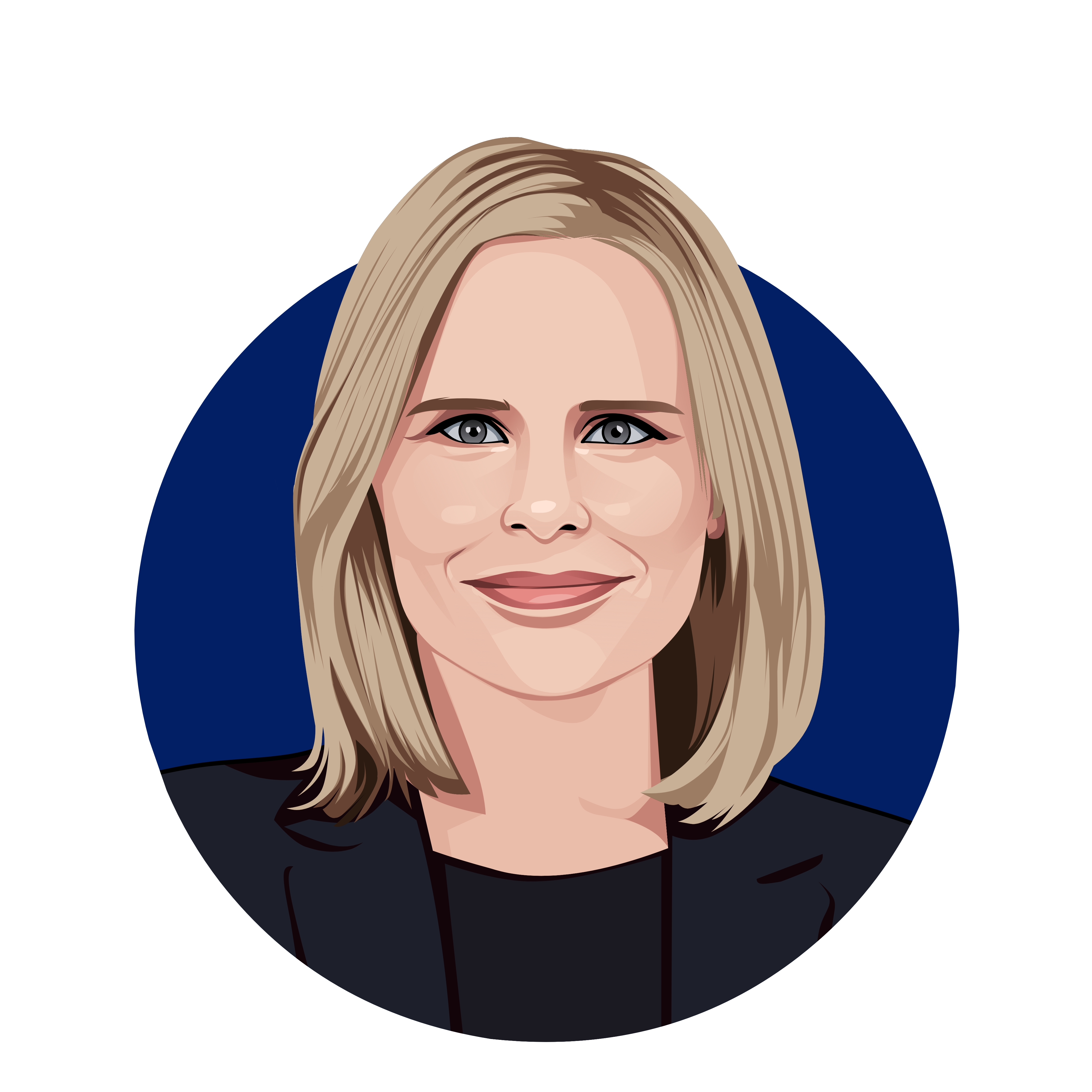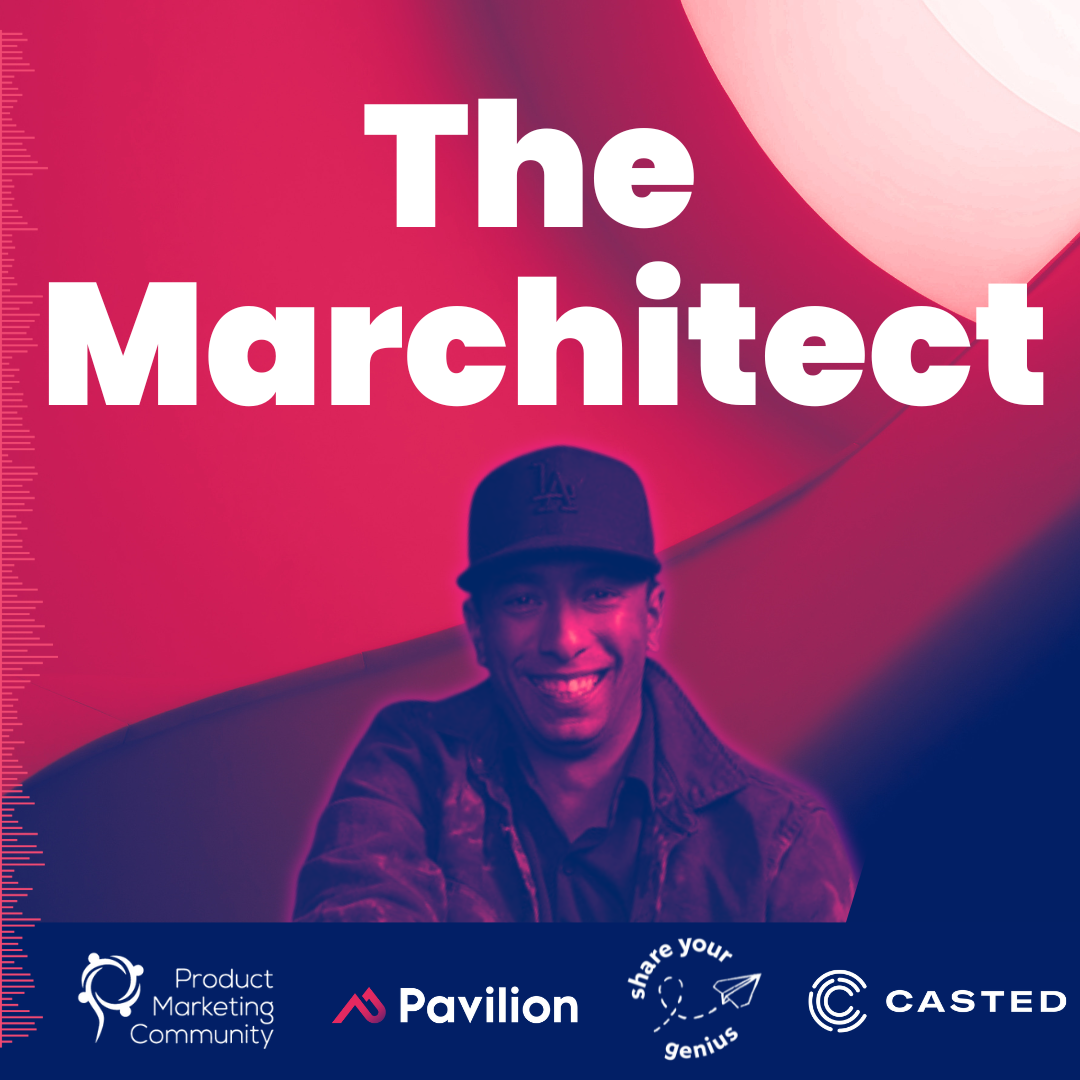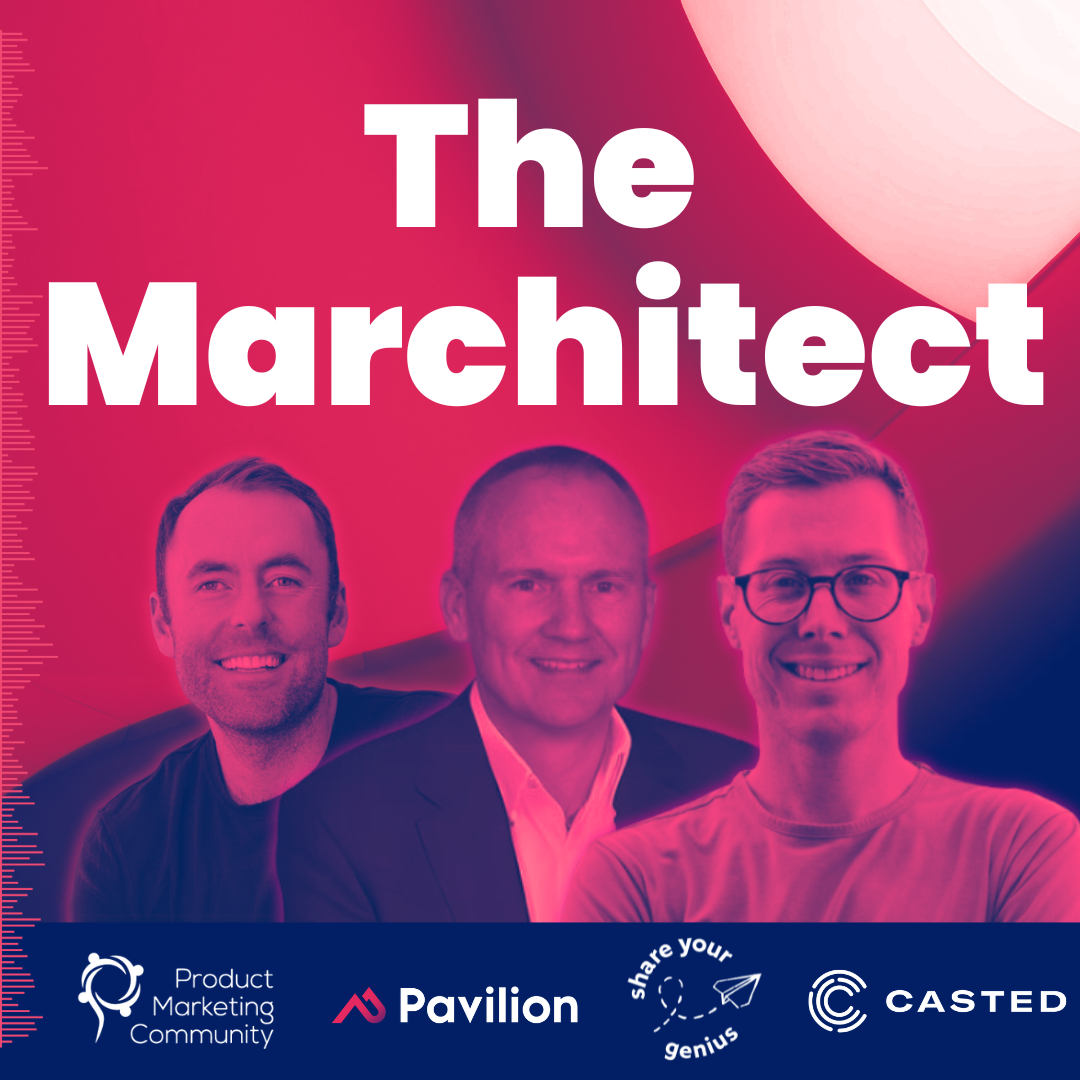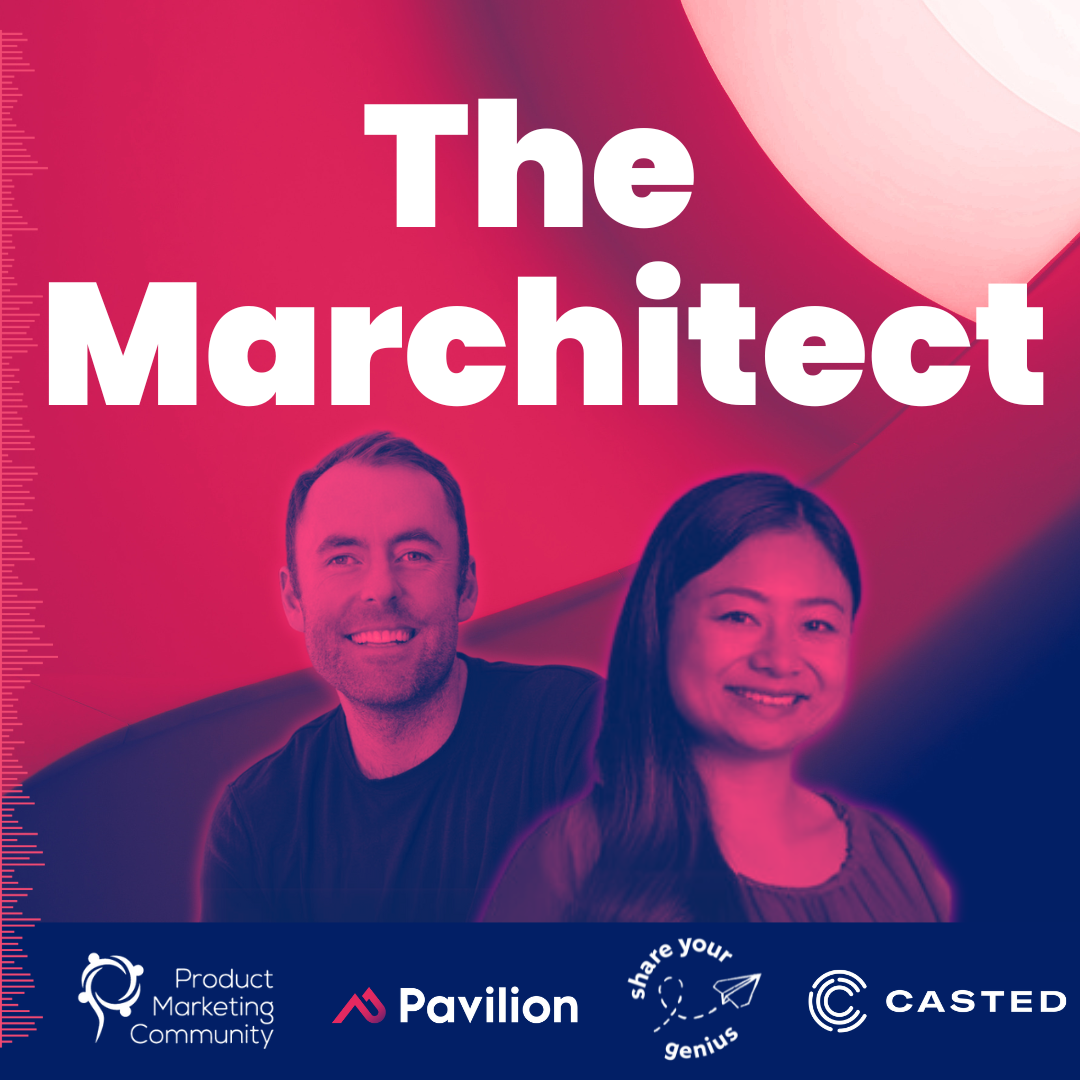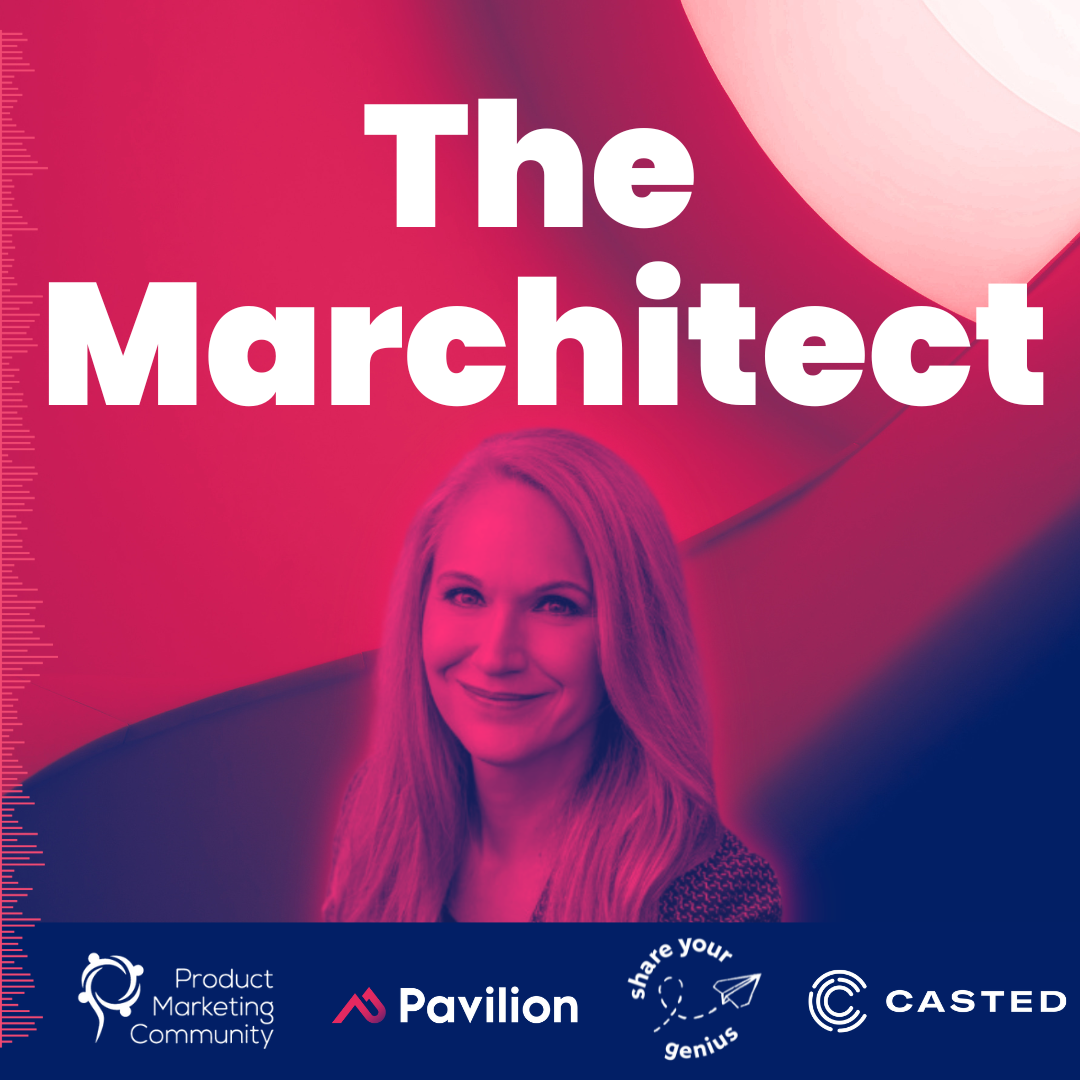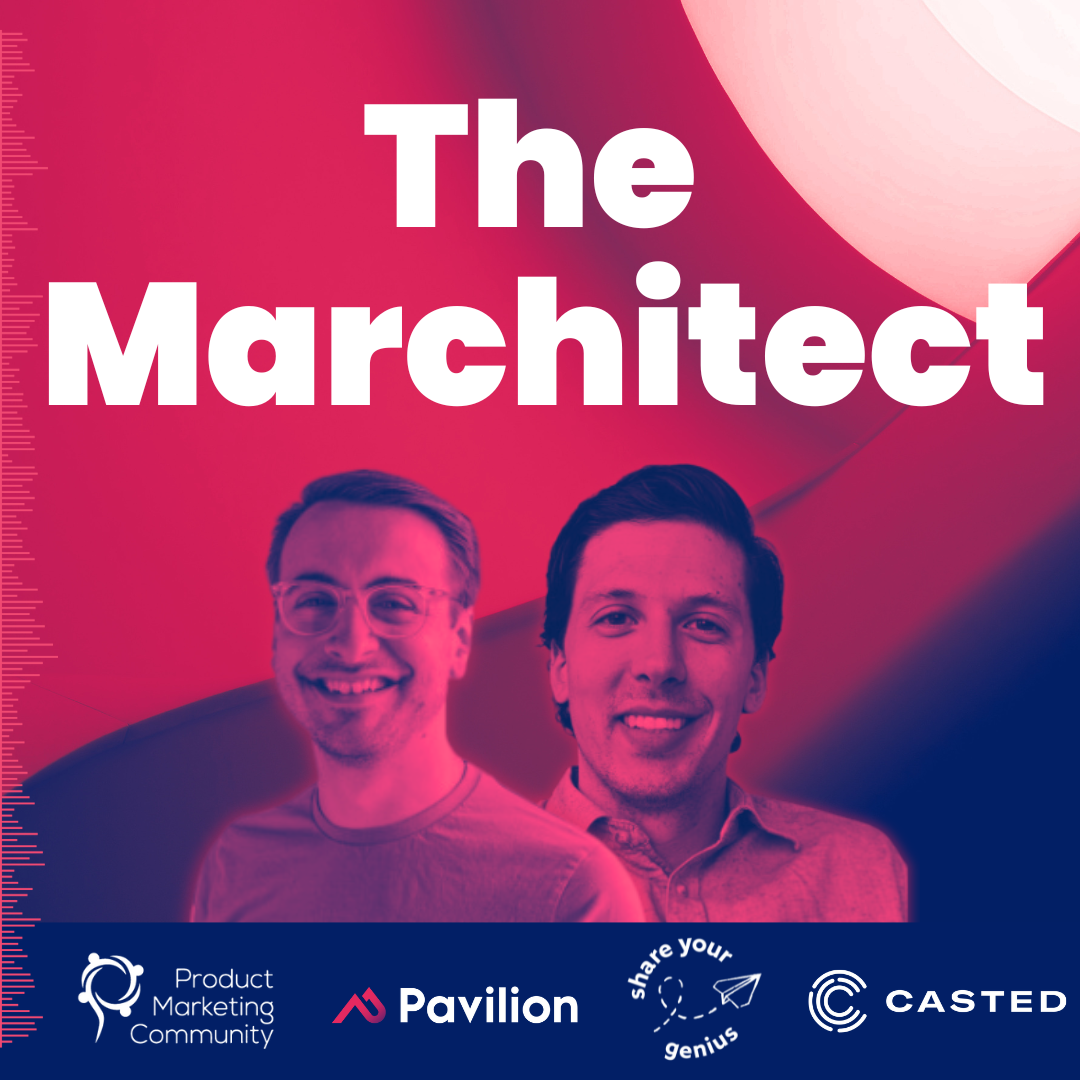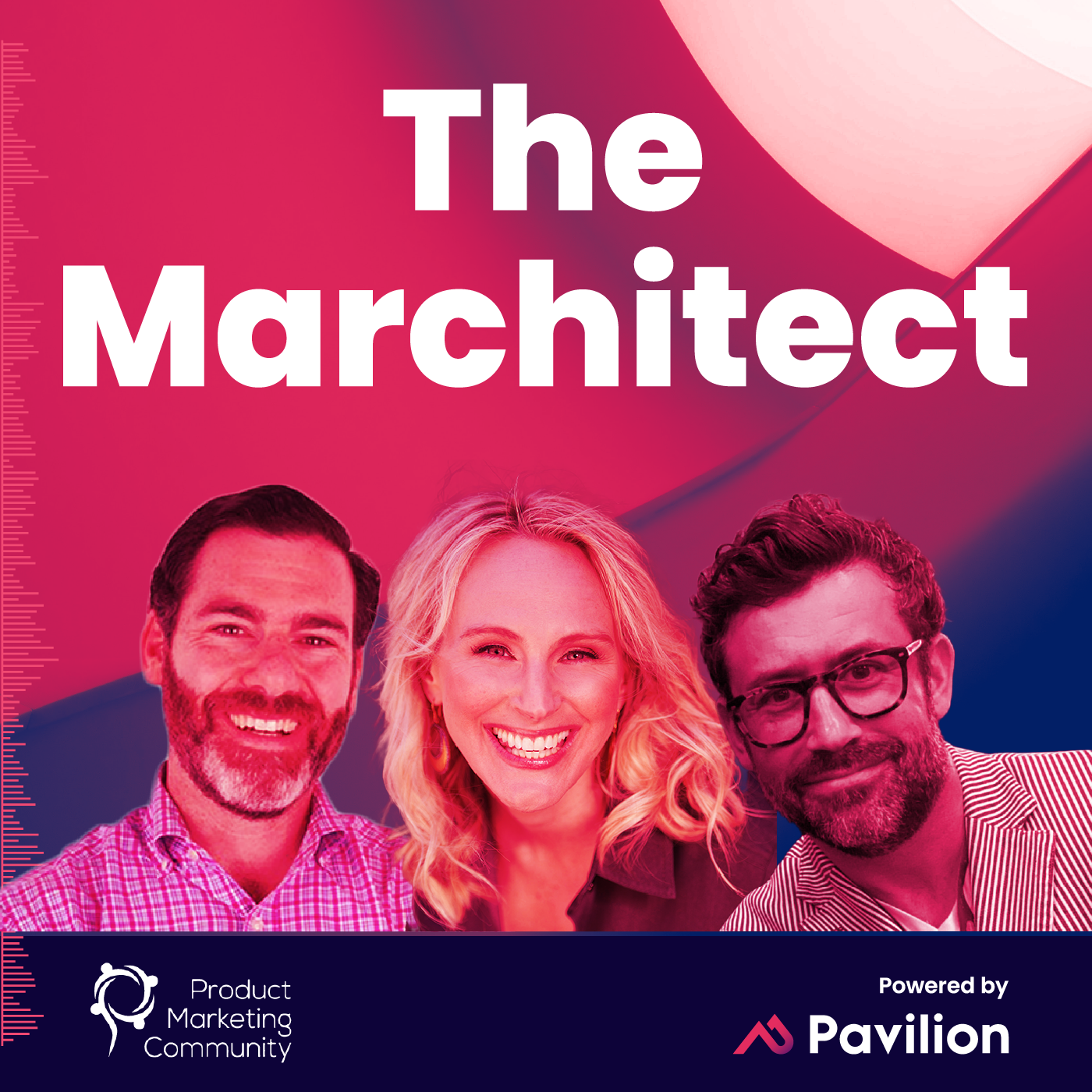Episode 5: Accelerating Growth with Enablement & Storytelling (Seismic & Gong)
- 0.5
- 1
- 1.25
- 1.5
- 1.75
- 2
Lindsay Tjepkema: The tide has turned. B2B buyers and sellers interactions have changed. Welcome to the Marchitect a new podcast series for B2B product marketing executives. I'm Lindsay Tjepkema, CEO and co- founder at Casted, the first amplified marketing platform for B2B marketers and a proud partner of the product marketing community. We are very excited to be bringing you this special series that focuses on amplifying the expert perspectives, insights, and opinions of this brilliant community. Each episode will feature in depth advice from executives who will tell you how they built impactful teams, optimized go to market efforts and enabled customer facing teams. The Marchitect is an easily digestible way to learn from your peers as you aspire to be an architect for growth. Welcome and enjoy this episode.
Rowan Noronha: Welcome to Marchitect, where leadership and product marketing meet. Today, my co- host Irina Soriano, VP of Enablement at Seismic and I are going to chat with Julien Sauvage. I hope I got that right Julien.
Julien Sauvage: Yes you did, Mark.
Rowan Noronha: Fantastic. VP of product marketing at Gong, regarding how the Gong marketing team accelerates growth, specifically utilizing enablement and storytelling. At the start of every episode, you have to indulge me here. I asked these two fill in the blank questions and Irena, why don't we start with you? And then we'll go to Julien. I am in marketing because.
Irina Soriano: I am in marketing slash Enablement because creating outstanding buyer experiences is what I truly care about.
Rowan Noronha: Oh, love it, Julien onto you. Tough one to follow. There we go.
Irina Soriano: I was going to say tough one to follow. I am in marketing because I wanted to be a rock star and I don't have a good voice. That's a true story. And I feel like marketing is as close as it gets to rockstar status in the enterprise because we build brands. We tell stories. We amplify, we listen to the audience. We rock the stage. So that's my insert. What's not to like about being a marketer?
Rowan Noronha: Brilliant. And I'll say this Julien, Sheena, Devin, Elvis, Oodi at least to me, they tell me you're a rockstar in your short turn at Gong already. So mission accomplished. Okay. Last one, before we get to the Q and A portion. Irena, my definition of leadership is...
Irina Soriano: Is to be able to delegate confidently and trust the people that you work with. So it's, for me, it's key to build teams of people that are self- reliant and that diverse in that way of thinking.
Rowan Noronha: Beautiful. Julien, my definition of leadership is...
Julien Sauvage: My definition would be kind of three things. One is hiring. I hired the best talent. The second one is then I trust them and I guide them when I can. The third one is I keep a smile on. I tend to not take work too seriously.
Rowan Noronha: I love it. Especially after what we've gone through over the past year and a half, we all have to ensure we smile as leaders. This is at the end of the day, we're not curing cancer here. So I love that perspective. Okay. Let's get to it. I have tons of questions, but Irena, do you have something to start?
Irina Soriano: Yes, let's hop right in. So Julien, as a obviously an important leader at Gong, you and your team, you're responsible for growth. However, no one team can drive growth, right? It's a team sport if we're looking at it. So who are your key stakeholders and what's your strategy to drive strong collaboration with those guys?
Julien Sauvage: Yeah. Thanks Irina, a great question. I think I'll start by saying that in my head, product marketing is the connector like more than anything else. If you, and this is very American of me now, so I'm a little ashamed, but you take one of those personality tests that kind of tends to put people in the box, right? So you hate them or you like them, you would do that with like say a hundred PMMs. I'm sure 95 of them will end up being the connector or the relationship builder kind of category or box. I think PMMs as a whole, just like bringing people together. So for me, our internal stakeholders, and I'm not going to teach anything, and our product sells, C- level execs, enablements people like you Irina, demand gen and brand. And I think driving strong collaboration is of course absolutely key. It starts with a lot of like listening and two way communication. So maybe trying to share something a little more like pragmatic and some of the tips, all the things that I do that I think help with that alignment and that collaboration, I can think of three things. One is a monthly newsletter, right? Internal newsletters. You would send that to, for some of the functions that you have, PMM, customer marketing, maybe thought leadership that just still helps a lot. But the second one is once a month, I tried to crash the party with my cross- functional peers. So I would go to the monthly revenue team revenue leadership team, weekly or same in CS. And I would just explain them what's going on in PMM or in marketing this month. That would be the second one. And then the third one is on a quarterly basis, at the beginning of each quarter, I try to do a bit of an internal roadshow. I think it's important to keep all teams really well aligned with everything that's happening for this quarter, what all the big bets, what are the key associated programs and then get some feedback and align with the teams around that. So it's just very simple communication tactics, but I've seen some of them being successful here.
Rowan Noronha: Love it. And Irina, I want to hear your thoughts as well. Before we get to you just to double click on something you said Julien, and I feel like I'm not saying your name in such a more impactful way, the way Irina says it. Irina, one more time. How do you say his name?
Lindsay Tjepkema: Julien.
Rowan Noronha: Julien. Okay. Julien, you said you crashed the party with your leather motorcycle jacket there. It seems fitting to crash their parties, but who are your two key peer stakeholders that you are always in conversation with and locked at the hip with?
Julien Sauvage: I would say it is more than two, but if you asked for two, I would say my CRO. So the sales leads and Enablement for sure. And I'm not saying that just because this is about enablement and PMM and Irina's in the room.
Rowan Noronha: Brilliant. Irina, that warms her heart, but Irina, who are your key interlock stakeholders from an enablement perspective and how are you driving that collaboration at Seismic or even amongst the customers that you hear best practices from?
Irina Soriano: Yeah, so fairly similar to what Julien just said. So at Seismic, we enable everybody who's customer facing. So that means I'll have product marketing teams, our sales teams, our sales engineers, our strategic alliances, our external partners and all of our customer successful. So everybody really who said C suite and below. So all the leadership teams, those are the key people that we have to work with, but then also our product team as much, right? So we have a whole stream that does product enablement, and that's very important for us to sync and make sure that we're all on the same page and really pull in from product over product marketing and then out to the rest of the team. So our audience is a little bit larger and so we really have to be the bridge to build out across the company to make sure everybody has what they need. And when it comes to just overall strategy, I agree with Julien, it's over- communicating. There's a lot of people with a lot of different objectives overall, right. That we can make sure we supporting everybody individually, but still can drive the overall mission and really the growth that the company is planning for. And ultimately the collaboration between product marketing enablement to me is one of the most important ones. If that's not a well- oiled machine, that's where the problems start. Right. So I always make sure whenever, even though it wasn't a new role or there's some change, somebody new comes in, like that's always the person for me that I want to be super tight with. And I feel that that impacts the rest of the team significantly as well.
Rowan Noronha: Love it. And so I'm going to go back to Julien on this one. You named quite a few stakeholders that you interlock with and then enable. So from a product marketing perspective, what are you and your team specifically, what does product marketing team, what are they doing to enable the revenue engine, if you will, to grow faster than the market and the competitors, of course?
Julien Sauvage: Yeah, there's a lot we're doing, as you would expect. I would say it always starts at the very top with a clear mission, vision, value props, company narrative, top level messaging. And you've put that in one of those frameworks, right? And there's like a thousand existing frameworks out there. So whatever they all work, but take the one framework that you like, and then you start putting things in paper and having kind of that period of messaging. And then you get into solution messaging, use case type of stuff, second call backs and whatnot all the way down, demos, product differentiation and whatnot. So I think it really would... Do we enable the field on his messaging at any level in that pyramid. And then of course, things like new pricing, new product, product launches, things like that. So this is like an arsenal of things that we try to reach our sales audience with. And I say, this is where the close collaboration with enablement is so crucial because they would help us really define the best sequence of events and the priorities because we can't enable everybody on everything all the time. So that pick and choose exercise is really key. And I rely heavily on my enablement partner to do that.
Rowan Noronha: Brilliant. And is product marketing, creating all the material and then training the trainer, meaning training the enablement team to go and do this, or is enabling facilitating the product marketing team and actually delivering a lot of this training, whether it's product message training.
Julien Sauvage: Yeah. I think it's a bit of both. It's kind of depends on like what level and what exactly is the topic of enablement, foreign language. I think at a high level, there's a cliche that I don't like as much, which is like PMM, we do content and enablement does channels. I feel like content versus channels. I don't think that works and love to hear some of Irina's point of view on that. I think it's partially true. I think when you are a PMM, you need to know the delivery mechanism. You need to know of course, the audience, the format, the certification process, and whatnot, before you start thinking about enablement, any enablement content and vice versa. If you're on the enablement side of things, you kind of need to be on the call and also be a speaker, welcome people. You're going to have the face of training and the learning and development to the sales teams. So you need to be a little dangerous on some of that content. Some of those things that demand would have built. So I think in that Venn diagram, I like when there's a bit of overlap and it's not just content and channels, but it's actually enablement doing a bit of content and PMM doing computer channel type of stuff.
Irina Soriano: I would totally echo that. So I think there's a collaboration there. To me, the piece is so, we wouldn't produce anything value or messaging related, right? That's the PMM team. That's super black and white. And I think that's the same in your organization as well. Where the overlap then really starts for us is we make sure we have a seat on the table when content gets built. What sometimes happens, if you have more experienced PMMs, it's fairly easy because they know the audience that they're working with. Sometimes when there's less experience. They might not know. So we might end up with a piece of content that sounds heavily technical, which as a seller, I wouldn't use because it doesn't speak to my audience. Right? So to me, it's really, we are the voice that brings them the voice off the audience. So we can impact as content is built. So we'll already part of the journey. So there's no like handover, yeah give you a throw a piece of content over the fence and wish you good luck with it. We then take the content and we activate it, right? Meaning there's obviously many different ways if we run it in person or if we do self- learning on it, or if we build something for us in Seismic, right. And we push something out, throw our new center. So there's many different ways how we can do that. But that collaboration for me starts like from day one. Right. So if we're not involved in that process, that's when things get kind of disjointed and it's not a well- oiled machine, what it should be. And then obviously there's enablement content. We're building, right, for the sessions that we're enabling and where we're activating the PMM content. So it's a little bit of both for us, but yeah, like I said, that collaboration is important and that would actually kind of lead me to my next question to you, Julien. So like I said earlier, for me, the relationship between enablement and the product marketing team, that's just key to success. If that's broken, no good enablement. Right. So how will you ensure that your team is also clear on swim lanes and responsibilities and what's the black and white, and what's the gray because I often get that question from enablers, that say my PMM team thinks I should be doing all of this or vice versa. Right. And I'm like, how am I going to deal with this? So I'd be keen to hear your take on that.
Julien Sauvage: Well, first off I think we're just slacking. I want enablement to do everything for me. I'll be hanging out by the pool. That's my default answer, but yes. Yeah, yeah, exactly. So yes, tons of overlaps as we said, and gray areas, for sure, as I said, the content versus channels thing is one area of overlap in that Venn diagram. We need that. We need the intersection, it can't be separated. I think another one is sometimes PMM doesn't realize that enablement enables and trains the field on stuff that has nothing to do with PMM and vice versa. PMM works on stuff that the field does not have to be enabled. It's not like every piece of collateral needs enablement, right? So it's just like a bit of an acknowledgement of, there's a lot of stuff that each team is doing. And sometime we intersect. And sometimes we don't. When enablement is running onboarding classes or things around like sales, methodology, salesmanship, skills like that. This is not a PMM thing. And so a lot of PMMS are like, oh, I don't know enablement is doing. I'm mad, whatever. So that acknowledgement, I think, really needs to happen. Or like sometimes we in PMM work on things like events messaging, right? We build keynotes and whatnot. I don't think that's something that necessarily needs to, the fields needs to be enabled on. So as I said, the finding the Venn diagram and then also like acknowledging that they're all things that enablement does and PMM doesn't and vice versa. And lastly, I'll say, and it's going to sound a little bit cliche, but I really believe that I think common goals and OKRs or KPIs can lead the way you want, but like having a clear objective, whether it's asset utilization or filled adoption or actual pie or ACP growth, what have you, defined the objective, the data, and then we'll measure and succeed together.
Irina Soriano: Yep. Awesome. And that would kind of lead me to go in a little bit deeper Julien. So to maximize the productivity of your revenue engine, how do you ensure that you drive consistency for all of the go- to- market teams when it comes to telling the same stories?
Julien Sauvage: Yeah. Consistency is absolutely key. I'm not going to, I'm preaching the choir. I think there's a few things, right. It starts with PMM needs to really know what the needs are in sales and CS. I've seen too many cases, not at Gong, but at previous gigs and others where PMM kind of do their thing in their ivory tower, so to speak. And I actually don't know if that is going to be helpful to sales. They don't have a clear kind of research aspect in their messaging. They don't... They're not attending some of the sales calls. They're just kind of doing their thing. So I think consistency starts with like the clear scoping of any messaging project with a key, exec sponsor. There's no messaging work that ever should be done if you don't have a VP of sales or a VP of CS or somebody like that signing off on that. Right. So that's from the get- go, scoping, defining the need, the timeline, the people and whatnot. The second thing I would say about consistency is I think consistency is a function of having a simple and memorable story. It's hard to drive consistency if your messaging is all over the place and it gets into the weeds and then it goes back up there. Whatever. One of the things that I really like about Gong is I feel like our strategic narrative has remained pretty consistent because it's supportful story and that's before my time. So I'm not claiming any credit there and so it's like, if you have a story that's simple to tell and easier to remember, then that'll drive consistency by design, right? So clear alignment on goals and scoping, having the simple and memorable story will help with consistency. And the final thing I'll say is then you get into more of the tactical stuff where you can, as a PMM lead, work with enablement on having things like a corporate certification, standardizing on a few sales decks and demos, driving the alignment with the team, using tools like solutions like Seismic and like Gong and things like that. But that's a little more tactical. I really feel passionate about scoping the thing, right. And then sticking to a simple and memorable story. That will be everything for consistency.
Rowan Noronha: And Julien, you... Julien, you mentioned consistency a few times there. And so to ensure consistency, we have to have the right story throughout your organization. And that gets filtered down through customers, prospects, the industry as a whole. Enablement, the fuel for enablement is really stories and storytelling. So I would love both your take on this. Irina and Julien, who is for the story creation at Gong and Seismic, and what inputs are you getting to ensure that these buyers and customers can identify with this story?
Irina Soriano: Like I said before, I think that doesn't happen just in a vacuum, right? So, if I look at Seismic, obviously talking new narrative and how to tell the story, I think this requires the input from a lot of stakeholders that have to sign off on it. That includes myself, that includes CRO, that's include head off rev ops, et cetera, et cetera, obviously the marketing team, the product team. That's really how this whole thing comes together to make sure that we're all on the same page, that we all feel strongly and that we feel passionate about the story as well, that it represents us the right way. And then I think then it comes to really validating it with some of the sellers, right, going in and almost kind of pilot it and see how it lands with customers, right? Getting some validation that the story really lands and that people can relate with it. And that comes down to the specific audience that it's targeted at. So for me, this is all collaboration, collaboration, collaboration. Making sure that enough voices are heard, and then that there's not too many cooks in the kitchen either, but enough to make sure that you get a good, different perspectives on the topic as well. And then one person who really ties it all together, right? It's like the story builder that should for me, should be one person who's really bringing the whole thing to the point. What do you think, Julien?
Rowan Noronha: And Julien, whose feet is to the fire when it comes to the final story, when you're talking about revenue intelligence and the story behind... Who's feet is to the fire, who is the one individual or group of individuals that is responsible for creating the story of Gong?
Julien Sauvage: So I think storytelling, another theme, I'm very passionate about storytelling. People think it's the PMM thing, or people think it's a marketing thing. It's not, it's a C- suite thing. The CEO has to be the one who signs off the company, narrative, the strategic stories and whatnot. Of course, it's on PMM, in partnership with others to build that story, like in the [RACI, 00:23:06] If you were to like do some process around that, the approver is your CEO, the person who's responsible is the lead PMM. So I really feel like it's an ELT or C an E staff type of topic. And to Irina's point about like the inputs that kind of like inform this, it has to be heavily based in research. We use of course, Gong. Within Gong listened to a lot of calls to kind of know what the top things and themes and trends and whatnot, talk to sales and CS and whatnot. There's an army, there's a ton of data sources, but yeah. To me, PMM kind of drives the story, but the stories that the C level, not at the, just a marketing thing.
Rowan Noronha: I love it. And I echo that because the story and the strategic narrative is the strategy. So I fully endorsed that. I did have another question, but Irina, did you have something he wanted to ask of Julien? I don't want to hog the spotlight here.
Irina Soriano: No. All good. Go ahead.
Rowan Noronha: So from equipping your go- to- market teams with these powerful relatable stories, it's a must in today's selling environment. Before it used to be all about features and functions. Why is storytelling so crucial today as we try to differentiate ourselves? We talk about the MarTech stack and the MarTech stack used to be a few hundred vendors. Now, there's, I don't even know what the count, I've lost track, but the CMO, and to a certain degree at the CRO, they only have a certain amount of time in their day. They can't listen to everyone's pitches. Why is storytelling so crucial in today's, especially in today's selling environment?
Julien Sauvage: I think storytelling is the most ancient form of talking between humans, right? It's just like, we've always told stories from the very beginning. That's how language and then writing, and then history was created. So people tell stories for a reason, it's fun and it's memorable. And if you apply these two things to the enterprise, that's why everything needs to be storytelling in the enterprise. There's no way I'm going to remember the tiny product details of whatever, if I'm a prospect, if I'm a client, but I'm going to remember that one compelling story that my AE told me, because that's how my brain operates. So I think it's just human nature.
Rowan Noronha: And I love the fun aspect of how Gong tells your story. You guys do everything very differently. You guys take a page out of the B2C book, more so than the B2B. B2B is very feature function, buttoned up to a certain degree, whereas in B2C, they play to your emotions. They allow themselves to have some fun. And so I believe a lot more B2B organizations ought to take a page from a B2C perspective in how they tell their stories. Irina, for whether at Seismic or even amongst your customers. What does enablement, what does success in enablement look like? And then so that's for enablement and then what does successful storytelling look like as Seismic as well?
Irina Soriano: Yeah. So starting with the storytelling piece, like for me, if I even just think about our sellers, right? Things have changed. We know that. This would have happened anyways 10 years from now, but everything that was happening in the world has just sped up this process. And if I'm a seller and I want to differentiate myself, the copy paste in mail, it's not going to fly here anymore. Right. That's over. And everybody's now online. Everybody is on social, that's how these interactions happen. So the person that tells the best story and that approaches bias that way, that's the person that's going to win. That's the person I'm going to answer to, out of the 50 in mails I'm getting, over the course of the month. So for me, it's really about the differentiation. If you tell the best story and the most engaging story, that's going to be the person who's going to win in the end. That's going to be the person who's creating an outstanding buyer experience from the first interaction, all the way to signing on the dotted line and then becoming a customer for life. So that's for me on the storytelling front. When it comes to enablement, like what's success look like here. So I've always approached enablement, not just as the fire department, which some of us often become like, ah, let's just give to enablement. They going to do it. Right? So that's, we don't want to be in the popcorn mentality. That's bad. So the whole goal for us is to be a strategic part of the organization and that means that we have to build an enablement ecosystem. And that's what we're doing at Seismic. And that has five key components. So the first one is that we have to, that's in collaboration with the marketing team, helped define the customer life cycle and all the different buyer journeys. We then need to look at who are the different personas at Seismic that are involved in each of the buyer journeys, because they all have to be enabled. That means if you only enable sales, you've got a little bit of a problem because if your sales people are amazing, but your customer success team has never been enabled on anything, skilled story assets, then it's not going to be a good experience. Right? So that's kind of how we're looking at that next-
Rowan Noronha: Sorry and Irina I hate to interrupt you. This is a crucial point. You're talking about not buyer personas, you're talking about your own internal personas, meaning sales rep persona, customer success rep persona.
Irina Soriano: Right? So, and there's probably, I would say between nine to 12, that you, as the buyer, will encounter as you get in the process with us, right. Pre, post sale. So there's many more than just sales. Hence this whole field of enablement is evolving just beyond just sales enablement. Right? So that's crucial for us to define internally, who are we enabling? Who's on the list. Who's going to get all these services that we're offering? And then the next step is that we have to define competencies to make sure that we're hiring the right people and skill sets for all these personas, right? And at Seismic, we have 15 for each of the personas, right? And some of them are overlapping. Some of them are not. And the next step is that we're building out skill development programs around those, that are very functional and or technical in nature. And the last step is to make sure that everybody, all your personas, have access to assets and quality content, not just sales. There's more people that we have to make sure that have access to that. So those are the five big milestones for us to create an ecosystem at Seismic. And we're right in the middle of that, we're not done. I've been here for 18 months, we've made huge progress. But then we know that we also still have a little bit of work to do, but I think that's for me, that's the modern view of looking at enablement.
Rowan Noronha: Oh, I absolutely love it. The enablement ecosystem, my God, I am going to steal that for sure. Julien.
Julien Sauvage: Yes.
Rowan Noronha: What does success look like for you regarding an enablement?
Julien Sauvage: Yeah. Regarding enablement. I think at the end of the day, I kind of don't enjoy the enablement utilization or adoption stats and metrics as much. I think activity doesn't mean progress. Right? So I always want my team and my enablement partners to kind of take a look at the actual hard business metrics. You can run a thousand trainings, but if they're not done well, or if the messaging is off, that will have no impact or maybe a negative impact on things like revenue, win rate pipe, what have you. So to me, my success criteria is, are kind of always hard business metrics. I will say in PMM, what I love is the broad spectrum of such metrics. What I hate is the broad spectrum of such metrics, right? It's beautiful because we can touch every KPI that really helps companies run better. And at the same time, it becomes overwhelming, feel defined, and it's kind of hard to report on. So I always try about KPIs to go beyond the usual pipe in ACV or pipe in AAR things. Of course, there's things at the very top of the funnel with downloads and views and third- party mentions and what and whatnot. That's what kind of best describes your word at the category level. Then if you move down the funnel of course, would have pipe, big fan of conversion rates, like seeing the impact of the piece of collateral or an enablement program on the velocity of the stages, right? Like, do I go from prism one to two, a little faster? Do the conversion rates get higher and whatnot? Win rates of course is big. We like win rates by competitor, win rates to status quo. So trying to get as granular as possible to be able to take action. I guess we don't do just analytics and reporting for the sake of it. We measure success to be able to constantly improve the next thing. And so that's why you have to get to know more grandeur when it comes to metrics. Sorry. It was a long winded answer, very non inaudible of me. But I feel really passionate about the KPI, the success criteria when it comes to PMMs and marketing in general.
Irina Soriano: So Julien, I have another question for you as we wind down, if you had a rally cry for your product marketing team right now, as we come out of the pandemic and we embraced the new normal, and I don't really like that term, but I guess that's what it is, of how buyers and sellers interact. What would that be?
Julien Sauvage: So the advice, I guess I would give to pretty much any team, any marketing team is to talk less, listen more. Talk less, listen more would be my thing. I think we always, because we're, it's Zoom calls all day long. We always talk, we talk, talk, talk. We don't listen to one another and it starts with good listening. So that would be my rally cry, talking less and listening more.
Irina Soriano: I love it.
Rowan Noronha: Brilliant. So today, Julien shared with us that he loves to crash parties to ensure in a lock- in collaboration. Irina shared with us the five steps that she takes to ensure the enablement ecosystem is present and put together at Seismic. I love it. Last fill in the blank, indulge me. Product marketers can be architects of growth for the company. If they...
Irina Soriano: If they understand buyer's needs and can translate them into engaging stories.
Rowan Noronha: Beautiful. Julien.
Julien Sauvage: Almost kind of stole my words. This is good. Yeah. I would say architects of growth for the company. If they think strategically, if they're able to synthesize all the signals and all the data from the noise and then execute flawlessly through targeted programs. So think, synthesize and execute.
Rowan Noronha: Brilliant. Julien, thank you so much for your time today. Irina, it was a pleasure. Have a good one folks. All the best for the second inaudible of the year.
Irina Soriano: Thank you.
Julien Sauvage: Cheers.
Lindsay Tjepkema: That's the show. Thanks for joining us. Make sure to visit productmarketingcommunity. co to subscribe and get more information on how you too can become an architect at your organization.
DESCRIPTION
In this episode of The Marchitect, Julien Sauvage (VP, Product Marketing @ Gong), one of the best Marchitects in the game, “stopped by'' the podcast recently and shared how he collaborates with his key “interlock” stakeholders to both create a unified story for the market and accelerate growth in the Revenue Intelligence category.
In this session, we discussed:
- How Product Marketing is Driving Gong's Go-to-Market efforts
- How you as a Product Marketing Leader can align everyone to tell the same stories
- The importance of Storytelling and how you can differentiate your product in the market
- Opportunities where Product Marketing Leaders can enable the Revenue Engine
